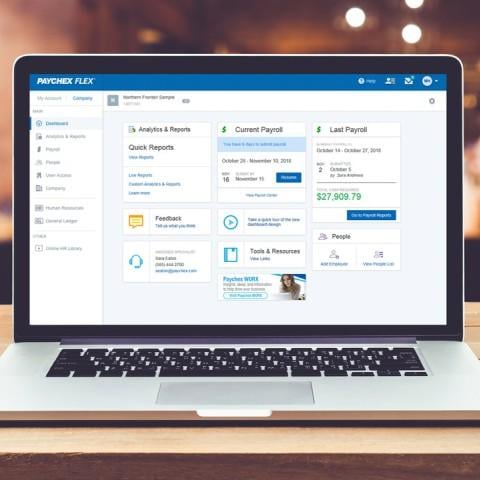- Nómina
- Artículo
- Lectura de 6 minutos
- Last Updated: 10/29/2024
2024 Year-End Payroll Checklist and Tax Guide

Table of Contents
As the end of the year approaches, it's important to ensure your payroll information is up to date. As you finalize your payroll activities and review compensation and benefits for the coming year, use this year-end payroll checklist and tax guide to help you stay on track with the numerous tasks associated with year-end payroll reporting and taxation.
Even if you're experienced with end-of-year payroll, it can be easy to overlook crucial steps at two critical junctures: the last payroll of the calendar year and the first payroll of the new calendar year. An organized year-end payroll checklist can help ensure you don't overlook any significant steps in the process.
Payroll Checklist: Before the Last Payroll of the Calendar Year
Many steps are involved in filing payroll taxes and preparing for year-end payroll. Here's a closer look at some steps you can take now to prepare for the end of the year, even before your last payroll.
Verify Business Information
Your business information on file for tax purposes should always be accurate, so now is a good time to verify that these details are correct. Specifically, it’s a best practice to confirm your state and federal employer identification number (EIN), as well as your company name and address. You'll want to do the same with your state unemployment account number(s).
Review Compensation for Next Year
As you prepare your budget for the coming year, it's important if you want to factor in any expected pay raises for your staff. Of course, the specific amounts will likely depend on what the law requires (e.g., minimum wage/salary thresholds), as well as what you can afford after factoring in costs such as current employee compensation and payroll taxes.
Here are some things to keep in mind:
- The wage base for the Social Security portion of FICA in 2025 is $176,100, meaning employers will pay more FICA taxes. The 6.2 percent share will be applied to this higher wage base, released in mid-October.
- For non-exempt employees, it's important to verify you follow any minimum wage rate increases for the states and localities where your business operates.
- For most exempt employees, it’s important to ensure they are being paid appropriately (e.g., receive at least the minimum threshold each workweek on a salary or fee basis) under the Fair Labor Standards Act (FLSA). Additionally, businesses in certain states also need to check if any salary threshold changes are taking effect that would require adjustments for their exempt employees above and beyond any changes a business might make to meet the FLSA’s requirements.
Review Bonuses
Some companies choose to offer bonuses to employees. Bonuses may be tax-deductible, but when do you deduct them? Assuming that you report your income and expenses on a calendar-year basis, then:
- If you are a cash-basis business: Deduct the bonuses in the year they are paid. If you pay bonuses in 2024, they're deductible for 2024. If you pay 2024 bonuses in 2025, they're deductible in 2025.
- If you are an accrual-basis business: Bonuses declared (and accrued) before the end of the year are deductible this year if they are paid within 2½ months after the close of the year (provided that the employee is only required to be employed on the bonus declaration date and not on the bonus payment date). However, bonuses paid to S-corporation shareholder-employees are not deductible until paid. For owner-employees in a C-corporation, the bonus is deductible only when paid in the case of a personal service corporation or for the majority (more than 50 percent) owners.
Depending on the type, bonuses may also have an impact on overtime paid to nonexempt employees. Under the FLSA, bonuses are considered to either be discretionary or nondiscretionary:
Discretionary: These bonuses are typically paid solely at the discretion of the employer and are not announced to or known by employees in advance (e.g., bonuses for overcoming a challenging or stressful situation)
Nondiscretionary: These bonuses include those known to employees, creating an expectation to receive the bonus (e.g., attendance bonuses, production bonuses, etc.)
Generally, nondiscretionary bonuses must be included when calculating any overtime pay owed to a nonexempt employee for the period covered by the bonus.
Employers should consult with their attorney, trusted advisor, or HR Professional for assistance determining what impact, if any, their bonuses may have on overtime pay owed to nonexempt employees under the FLSA, as well as state or local law.
Inform Employees About Unused Benefits
Some of the benefits employees earned or paid into in 2024 may expire at the end of the year. Consider your company policies for these benefits and advise employees accordingly:
- Vacation, sick days, or personal leave time: Can unused days be carried over based on company policy and applicable law? And if so, are there limits to the amount that can be carried over? Are there any amounts that need to be paid out? And if so, are there timing parameters for when the payouts must occur? Note any paid time off that will expire at year-end and communicate this information to employees so that they can schedule and coordinate leave time accordingly.
- Flexible spending accounts (FSAs) for medical costs and dependent care: Historically, FSAs have a use-it-or-lose-it feature. Generally, amounts remaining in the account at the end of the year are forfeited. However, plans may allow employees to submit claims within a set time (run-out period) for expenses incurred in the previous year. For example, an employee may submit reimbursement for a medical expense incurred on December 15, 2024, by January 30, 2025. Typically, a medical FSA can also provide a grace period of up to 2½ months after the year's close for new expenses, or the FSA can allow for a carryover of up to $640 (from 2024) into the next year. The FSA cannot offer both a grace period and a carryover option. Advise employees about the terms of your plans.
Confirm Employees' Identifying Information
When it comes to payroll, the end of the year is a great time to check for inaccurate or outdated employee information. These inaccuracies can lead to costly delays, reprints of W-2s, and IRS-imposed penalties. Ask employees to confirm their full name, Social Security number, address, and additional contact information to help streamline your end-of-year processes and ensure that vital tax documents get to the correct location. This is also the time to ensure that deceased employees are correctly coded and that you abide by state laws regarding final pay for deceased employees.
Record All Processed Paychecks
While you won't be able to finalize your annual payroll and tax numbers until after the final pay period, you can certainly get a jump start on recording and verifying everything already processed. Review previous year-end pay stubs and past pay periods to ensure that all amounts are logged accurately by verifying the following:
- Employee wage amounts
- Benefits deductions
- Child support or other miscellaneous deductions
- Disability or other benefits payments
- Special tax exemptions that may have occurred throughout the calendar year
Check for Potential Tax Credits
As part of the Coronavirus Aid, Relief, and Economic Security (CARES) Act, the Employee Retention Tax Credit (ERTC) Service can help businesses claim the ERTC retroactively for previous quarters in which qualified wages were paid to eligible employees.
The credit is intended to fund businesses that kept workers employed during government shutdowns or had reduced gross receipts during the pandemic. While companies can no longer pay wages to claim ERTC, they have until April 15, 2025, to review their payroll during the pandemic and retroactively claim the credit by filing an amended tax return.
Generally, amended returns for 2021 tax periods must be filed by April 15, 2025.
Businesses could be eligible for:
- A credit of $7,000 per employee for any quarter before September 30, 2021 (for 2021).
- A refund if the taxes owed are less than the credit they're eligible for.
As of August 8, 2024, the IRS lifted the ERTC moratorium on processing claims filed after September 14, 2023. As a result, the IRS will begin processing claims filed between September 14, 2023, and January 31, 2024.
Order W-2s, W-3s, and Other Applicable Year-End Tax Forms
As mentioned, you must provide your employees with end-of-year tax statements via IRS Form W-2. You can get these necessary forms from your payroll service provider, printed from your payroll management system, or the IRS. If you plan to obtain blank forms directly from the IRS for manual completion, order them well before the end of the year so you can begin processing them immediately after the final payroll period.
Determine Your Payroll Policies for the New Year
While many businesses follow the same payroll schedule and policies year after year, you may consider changing your payroll structure. In the age of more employees expecting quick access to their paychecks, you may want to evaluate whether options such as pay-on-demand make sense for your business. The end of the year may be the best time to implement a change, so assess those decisions now. Determine the paycheck deposit schedule you plan to use in the new year and your options for employees to receive their paychecks.
Check for Special Circumstances
While these things may not apply to all businesses in every calendar year, you may have some particular tasks to complete if your business experiences any of the following:
- Newly hired employees or employees who didn't complete a W-4 at the time of hire
- Employees with voided or reversed paychecks
- Employees or former employees with active payroll disputes
If any of these situations apply, try to resolve these issues before the end of the year. Verify how these issues will affect your end-of-year payroll if that isn't possible.
Payroll Checklist: After the Year's Last Payroll and Before the First Payroll of the New Year
While much of the planning and organization on your payroll year-end checklist can be done in advance, there are several essential steps to complete after the final payroll period of the year. Once your final payroll period has been calculated, do the following.
Finalize Wage, Tax, and Benefits Information
Before finalizing your payroll for the current year, review your information to ensure everything looks accurate for each employee and your company. Total each employee's wages, taxes paid, and benefits earned throughout the year, then calculate summary figures for your business to use on the applicable year-end tax forms. This also includes any fringe benefits you offer, which are generally included in an employee's income and can include personal and sick days, partial tuition reimbursement, company car, or stock options. Make sure that you report fringe benefits under employee earnings.
Distribute Forms W-2 to All Employees
Once the final payroll for the year has been processed, you can print and distribute Forms W-2. Some payroll providers will send Forms W-2 directly to your employees. Regardless of delivery method, employees must receive a copy (or have access to download a copy) of their Form W-2 by January 31 of the following calendar year, so these forms must be calculated and distributed quickly.
File Year-End Payroll Tax Forms With the IRS and Deposit Taxes Owed
In addition to the payroll year-end dates mentioned earlier, part of your business tax obligations includes paying taxes owed on time. If your end-of-year payroll tax return shows that you owe taxes, these must generally be paid online via the IRS business tax website. While individuals typically have until April 15 to file personal income taxes each year, business tax returns, such as those for S-corporations or partnerships, and any taxes owed are generally due by March 15. Remember these essential filing dates as part of your end-of-year payroll checklist.
Review the Coming Payroll Year and Initiate Next Year's Payroll Schedule
After you have completed this year's payroll, review your payroll schedule for the next fiscal year. Check all period-ending and quarterly closing dates to ensure they do not fall on any major holidays, weekends, or other dates that would make processing in a timely manner difficult. Make any necessary adjustments to your schedule, then set up your new payroll plan for the coming year.
Review Applicable State/Local Minimum Wage Changes
Many states and localities have announced minimum wage rate increases, many of which are in response to inflation rates that continue to impact individuals and businesses nationwide. Scheduled increases are planned in numerous states and localities, with additional increases likely to be announced before the end of the year. Since many wage increases become effective on January 1, it's essential to consider this when determining compensation for the upcoming year.
What Is Year-End Payroll?
Year-end payroll is the careful review and verification of your financial information from the fourth quarter of the calendar year through the first quarter of the following year. Businesses are responsible for year-end payroll tasks related to employee payments and records, including:
- Accurately calculating tax liabilities, employee compensation, and deductions to be withheld from employee paychecks.
- Reviewing relevant tax documents to make sure you track all payments correctly in the new year.
- Completing and filing forms with the Internal Revenue Service (IRS), Social Security Administration (SSA), and state and local tax departments.
- Identifying and preparing for changes to local, state, and federal employment regulations that affect your business in the new year.
A payroll calendar can be a game-changer when planning for the upcoming year. It helps to ensure that all payroll-related administration is completed on time and that payroll delays are avoided.
Why Is Year-End Payroll Important?
End-of-year payroll is critical to tax compliance. It ensures all federal, state, and local taxes are calculated and filed correctly.
Businesses can avoid penalties or legal issues from missed deadlines or errors by closing payroll, issuing all forms (such as W-2s and 1099s), and reconciling accounts. Being on top of this process helps you meet your legal obligations.
In addition to compliance, the end-of-year payroll provides financial clarity. By closing the year with accurate records, you can confidently plan for the next fiscal year, aligning your budget and financial goals. Payroll accuracy supports your business and employees' tax planning while setting you up for a clean start in the new year.
When Does the 2024 Payroll Year End?
When submitting payroll forms and tax information, you should do everything possible to avoid important payroll year-end dates. Business tax obligations for year-end payroll will vary by state, business size, industry, and several other factors, but most businesses will be required to file:
- An annual business tax return, whose filing deadline depends on your business structure (March 15 for partnerships, multi-member LLCs, and S-corporations; April 15 for C-corporations).
- Forms W-2 and W-3 for each employee by January 31.
- Form 1099-NEC for contractors by January 31.
- Form 940 and fourth quarter FUTA taxes deposited by January 31.
- Quarterly Form 941 tax return or the annual Form 944 by January 31, depending on when you file.
Be mindful that proper preparation for year-end payroll taxes begins well before the end of the year. It's always a good idea to keep accurate and up-to-date payroll records throughout the year to help you meet required deadlines and make these tasks as straightforward as possible. This is a great addition to your end-of-year payroll and tax checklist.
What Happens if You Miss a Year-End Payroll Tax or Deadline?
Missing a year-end payroll tax deadline can have financial and legal consequences for your business, including penalties, interest, and IRS scrutiny. Late filings can also result in fines and unnecessary stress.
In addition to penalties, you may face audits or deeper dives into your payroll practices, which can bring more administrative burdens. You should meet all tax deadlines to avoid disrupting your business and employees.
If a payroll deadline is missed, act fast. Here's what to do:
- Identify the problem: What was missed? A filing or payment?
- File now: File the paperwork as soon as possible, even late.
- Fix errors: If needed, file an amended return to correct mistakes.
- Call the IRS: If penalties apply, consider setting up a payment plan to pay the fine.
- Engage a professional: You may want to contact your accountant or tax lawyer to remedy the missed deadline.
- Review processes: Implement safeguards, like automated reminders or payroll software, to prevent future missed deadlines.
Taking these steps can help minimize further financial impact and ensure payroll operations remain compliant.
What Tax Forms Do You Need for End-of-Year Payroll?
As an employer, you must send employees and contractors specific tax forms by the end of January and submit wage and tax information to the SSA and IRS. Specifically, some of the year-end forms include:
- Form W-2: Reports employee wages and withholdings to the SSA.
- Form W-3: Summarizes the information in the W-2. This is submitted with W-2s to the SSA.
- Form 1099-NEC: A statement of income (any wages over $600) for contractors.
- Form 940: Filed with the IRS by businesses with one or more employees and used to determine the employer's federal unemployment tax (FUTA) based on the business's annual payroll.
- Form 941: Due quarterly and used to report wage withholding for income taxes, the employee's share of Social Security and Medicare (FICA) taxes, and the employer's share of FICA.
- Form 944: Applies to employers with annual tax liability who withheld federal income tax, FICA (employee and employer share) totaling $1,000 or less.
- Form 1095: As part of the Affordable Care Act, if you have an average of more than 50 full-time employees, including full-time equivalents, during the preceding calendar year or your business is self-insured, you must file Form 1095 with the IRS. Self-insured small companies must file Form 1095-B to report information on individuals provided minimum essential coverage, and employers with more than 50 employees must file Form 1095-C on health insurance coverage offered to full-time employees and their dependents. If self-insured, they must also provide information on individuals enrolled in coverage. Failure to file or furnish these forms on time could lead to penalties.
Key Year-End Payroll Dates To Remember
As we near the end of the year, it is essential to keep track of important payroll and tax deadlines to avoid late filings and penalties.
Year-end payroll requires attention to ensure that employee tax forms like W-2s and 1099s are prepared and distributed on time and that payroll taxes are paid to the IRS.
Missing these deadlines can result in fines or other headaches, so stay organized and smooth the transition to the new year.
To help with this, we've compiled a table of the most critical year-end payroll deadlines, form distribution, filings, and tax payments. This table is a quick reference to ensure everything gets done on time.
| Deadline | Task | Details |
|---|---|---|
| December 31 | Final payroll for the year | Process the last payroll of the year to ensure year-end reporting is accurate. |
| December 31 | Confirm compensation for next year | Confirm pay raises, adjustments, and minimum wage compliance for the coming year. |
| January 31 | Distribute W-2 forms to employees | Ensure all employees receive their W-2 forms by this date. |
| January 31 | File W-2 forms with the SSA | Submit W-2 copies to the Social Security Administration (SSA). |
| January 31 | Distribute 1099 forms to independent contractors | Provide 1099-NEC or 1099-MISC forms to contractors by this date. |
| January 31 | File Form 940 with the IRS | File federal unemployment tax (FUTA) return for the previous year. |
| January 31 | File quarterly Form 941 or annual Form 944 with the IRS | Report wages, tax withholdings, and Social Security/Medicare taxes. |
| January 31 | File 1099-NEC forms with the IRS | Deadline for filing 1099-NEC electronically or on paper. |
| February 28 | File paper 1099-MISC forms with the IRS | If filing by mail, 1099-MISC must be sent by this date. |
| March 31 | File electronic 1099-MISC forms with the IRS | Deadline for filing 1099-MISC electronically. |
| April 15 | Retroactive ERTC claims deadline | File amended returns for Employee Retention Tax Credit (ERTC) claims from 2021. |
Organizing these key dates in advance allows businesses to stay on top of their payroll requirements and reduce the last-minute rush that can lead to mistakes or missed deadlines.
Ensure You Start 2025 Payroll Strong
Working with Paychex has its benefits. Paychex Taxpay® can help your business apply for potential tax credits, reduce your risk of penalties, and file your payroll taxes — all in one convenient location.


Tags









